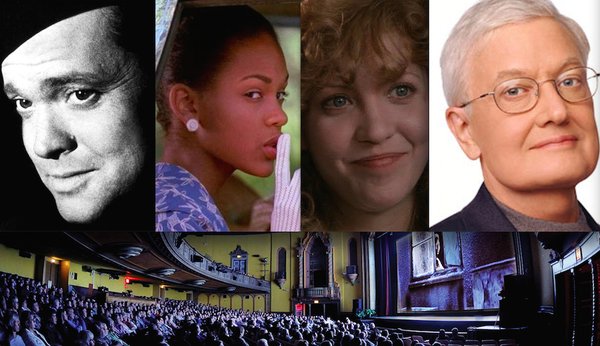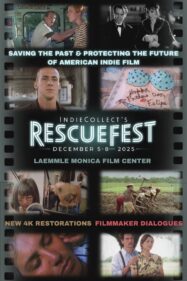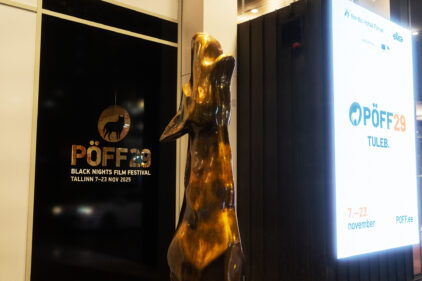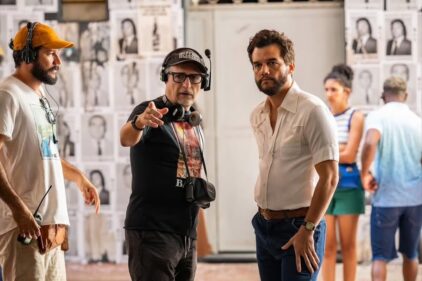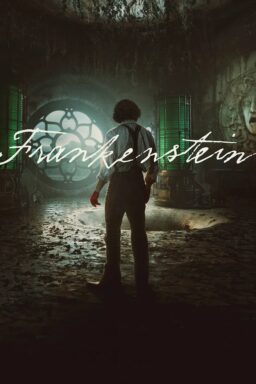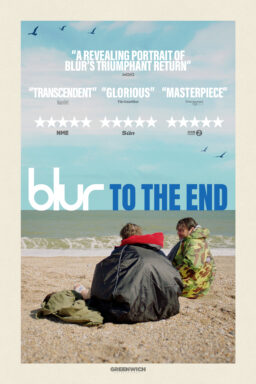Ebertfest, a celebration that has
brought the world of cinema in all its potential forms to Champaign, Illinois
and the historic Virginia Theatre for five straight days of moviegoing and good
companionship since 1999, has overcome the potentially crippling loss of its
founder, the late, great Roger Ebert and, to judge by the lineup of films put
together by the crack staff of programmers under the guidance of that
indomitable force of nature that is Chaz Ebert, is stronger than ever. Now, I
realize that some of you may be thinking that a claim like
that is nothing more than polite boilerplate but I promise you that in this
case, it is all true and then some. The collection of films on tap for
this year is truly one of the best in the history of the festival.
Running April 13 – 17, this year’s festival, which is dedicated to the memory of the celebrated cinematographer/filmmaker/beloved
Ebertfest guest Haskell Wexler, offers up another provocative, eclectic and
entertaining collection of 12 titles that spans the entire history of film from
the silent era to today. There is an elaborate horror fantasy from one of the
most celebrated names in contemporary genre filmmaking. There are a couple of
thought-provoking documentaries that are as unique as the subjects that they
cover. There is a stirring biopic on one of the most innovative musical
geniuses of our time. There are two masterpieces of the silent era that will be
presented with musical accompaniment. There are films dealing with such
familiar topics as abortion, religion and dark family secrets, but not
presented in any of the familiar ways. There is the latest effort from one of
the festival’s favorites and a film that pretty much defies
description and is all the better. Finally, there is the title that I would not
only cite as being the best of this year’s festival but which also has a place
of honor on my list of my Top 10 all-time favorite films.
In addition to the films themselves, filmmakers, actors, scholars
and critics will be on hand to participate in discussions after the screening
and during panel discussions on the mornings of April 14 – 15 at the Illini Union
(1401 Green St. Urbana, IL). For more information on the films, guests, ticket
availability or any other information, please go to the festival website by clicking here.
Here is a film-by-film overview of this year’s lineup.

Wednesday, April 13
CRIMSON PEAK (2015): In Guillermo del Toro’s lavishly
appointed merging of the horror and Gothic romance genres, Mia Wasikowska stars
as a young heiress and aspiring author who, against her father’s wishes,
marries an ambitious Brit (Tom Hiddleston) and goes off to live with him and
his oddball sister (Jessica Chastain) in their crumbing family home built atop a
mountain of red clay that literally bleeds through the snow. Before long, however,
it becomes apparent that the house is teeming with forbidden rooms, strange
artifacts and even a few ghosts and that someone—or something—is out to get
her. When I first saw this film, I was torn between my admiration for its
stunning visual style—between the nifty special effects and the sumptuous
production design by Tom Sanders, this is one of the best-looking films of any
genre in recent years—and the inescapable fact that the story is a curious
letdown that cribs from the oeuvre of Henry James and contains a number of
theoretically shocking plot twists that will come as surprises to precious few
viewers. Upon further review, it is easier to overlook the plot deficiencies in
order to further bask in its look, which should seem even more astonishing when
projected on the Virginia’s big screen. As an added bonus to this screening,
del Toro himself will be on hand for the post-screening Q&A. (7:00 PM)

Thursday, April 14
GRANDMA (2015): Lily Tomlin is, of course, one of the
great American comedic voices of our time but Hollywood has never really known what to do with her. Although a familiar face on the big screen ever
since her Oscar-nominated debut in “Nashville,” she only appeared in one film since,
the uneven remake/spoof “The Incredible Shrinking Woman,” in which she was the
sole central character before appearing in this indie comedy-drama from
writer-director Paul Weitz (whose previous efforts include “American Pie,” “In
Good Company” and “Admission,” which featured Tomlin in a supporting role). Tomlin plays Elle, an acerbic poet who, on the very day she has broken up with her
much-younger girlfriend, is unexpectedly visited by her granddaughter Sage
(Julia Garner), who is pregnant and in need of $600 for an abortion she has
scheduled for that very day. Temporarily light in the financial sense herself,
Elle hits the road with Sage to try to scare up the cash and both find
themselves confronting their uneven pasts and uncertain futures along the way.
The setup is a bit rough but once the two hit the road, the film turns into an
alternately hilarious and touching meeting of the minds between the older
generation that fought on the front lines for women’s rights and the younger
one that oftentimes takes those rights for granted. As Elle, Tomlin is
absolutely spectacular throughout. She shares a scene with
Sam Elliott, who turns up as a man from her past who still has feelings for
her, that’s so funny and heartbreaking that it could have been spun off into its own movie. Weitz and
producer Andrew Miano are scheduled to appear at this screening. (1:00 PM)
NORTHFORK (2003): How does one even begin to describe this
strange and haunting film from the fraternal filmmaking duo of Michael and Mark
Polish? In his review, Roger Ebert suggested a combination of “Days of Heaven”
and “Wings of Desire.” While that doesn’t quite capture it entirely, such a
comparison will do until someone comes up with a better one. Set in 1955 in a
small Montana town about to be flooded over to make way for a hydroelectric
dam, it tells three seemingly dissimilar stories that eventually pull together
in unexpected ways. In one, a group of enforcers (including James Woods) try to
convince the few lingering townspeople (including one who has built and stocked
a full-size ark, complete with two wives) to leave their homes. In another, the
town priest (Nick Nolte) desperately tries to find a couple willing to adopt a
deathly ill orphan (Duel Farnes) in his care, no questions asked. Lastly, a
group of honest-to-goodness angels (including Daryl Hannah and Anthony Edwards)
arrives in town searching for a missing member of their group. Balancing
moments of harrowing drama, tenderness and offbeat comedy (there is a seemingly
throwaway moment involving several men ordering soup in a diner that never
fails to crack me up), this is that rarest of cinematic beasts—a genuine
original. Even you somehow don’t like it, you will still come away from it
with an admiration for the Polish Brothers for having the nerve to even attempt
something this unique in the first place. Michael Polish will participate in a Q&A and trust me, there will be Q’s aplenty
with this one. (4:00 PM)
THE THIRD MAN (1949): There is a part of me that almost
wanted to leave this entry blank. Those who have seen it
before do not need me to suggest to them that Carol Reed’s thriller set in the
seedy underworld of post-war Vienna is one of the great titles in the history
of the cinema; those that somehow have not seen it should have the chance to
experience its glories with the freshest possible eyes. Suffice it to say, the
film, which follows pulp fiction author Holly Martins (Joseph Cotton) as he
tries to get to the bottom of the mysterious death of old acquaintance Harry
Lime in an investigation that leads him to the then-thriving black markets for
vital materials then in short supply and forces him to face some unpleasant
truths about his friend, is one of those rare films where virtually everything
works. The screenplay by Graham Greene is by turns funny, gripping, dramatic,
romantic and mysterious. It somehow manages to suck you in no matter how many
times you have seen it. All of the technical aspects from Robert Krasker’s
Oscar-winning cinematography to Anton Karas’s instantly familiar score are
top-notch and the performances from Cotton, Alida Valli as a former lover of
Harry’s and Orson Welles as Harry Lime himself are all great. Despite only
appearing on the screen for about five minutes, Welles’ presence thoroughly
dominates the proceedings even when he isn’t seen and when he does finally make
his long-awaited appearance, it is arguably the single greatest entrance ever
filmed. The Q&A following the screening will include Angela Allen, who
served as the script supervisor for the film, one of the first credits in a
career spanning more than a half-century that saw her working with such
filmmakers as John Huston, Robert Aldrich and John Frankenheimer and on films
ranging from “The African Queen” to “Labyrinth.” (8:30 PM)

Friday, April 15
DISTURBING THE PEACE (2016): Co-directed by Stephen Apkon
and Andrew Young, this new documentary looks at an old conflict—the tensions
between Palestine and Israel—through the eyes of a group of soldiers from both
sides who have decided that the violence between them has to stop and made the
move from being combatants to non-violent activists pushing for peace instead
of war. Apkon and Young are both scheduled to attend the screening, along with
two of the film’s subjects, Israeli Chen Alon and Palestinian Sulaiman Khatibi,
and story consultant Marcina Hale. (1:00 PM)
L’INHUMAINE (1924): One of the highlights of each
Ebertfest is the chance to see a classic silent film screened in a theater old
enough to have played such films during their original runs, as accompanied by
a live score performed by the Alloy Orchestra, a three-man ensemble that
specializes in performing music for such films using a combination of
electronic synthesizers and some of the more unusual percussion devices that
you will ever see. This year’s offering, to put it in critical terms, is a
doozy and a half—a surreal and stylistically stunning tour de force from
director Marcel L’Herbier that was way ahead of its time when it first came out
more than 90 years ago and remains so today. The film tells the story of a
femme fatale (Georgette Leblanc) and her four main suitors—an American producer
who wants to make her a superstar, a Russian who wants to use her to help
inspire a revolution, a maharajah who wants her to become his queen and a
scientist who just loves her for herself—who get together at her mansion for a
banquet destined to go down as one of the craziest meals in cinema history. To
say that the film is bizarre is an understatement for the ages and by most
critical standards, it doesn’t really work at all—none of the relationships are
especially convincing and it becomes quickly apparent that Leblanc, a opera
singer who had never been in a film before, had no idea of how to act in front
of a camera and was charitably at least a couple of decades too old for her
part. (Her casting can be explained largely due to the fact that she apparently
financed the project.) And yet, despite these flaws, the film maintains a
hypnotic hold on the viewer thanks to its flamboyant visual style and
cheerfully crazed plotting that will throw even the most jaded for a few
loops—whether you love or hate this film, it is not possible that you will
forget it anytime soon. (4:00 PM)
EVE’S BAYOU (1997): “Memory is a selection of images, some
elusive, others printed indelibly on the brain. The summer I killed my father,
I was ten years old.” With those instantly memorable opening sentences, this
utterly unique drama from actress-turned-director Kasi Lemmons instantly
establishes a mood that draws viewers into a story that is complex both in
terms of the narrative it relates and the emotions that it explores. Set in the
summer of 1962 in Louisiana and seen through the eyes of ten-year-old Eve
Batiste (Jurnee Smollett), who witnesses her beloved father (Samuel L.
Jackson), a man who is married to the most beautiful woman in town (Lynn
Whitfield) but still has a roving eye, with another married woman, an incident
that will eventually have great repercussions for her entire family after she
confesses what she saw to her older sister (Megan Goode). I wouldn’t dream of
saying anything more except to say that if you think you know where the film is
going from what I have described, you are going to be surprised. Instead of
telling the story in a straightforward manner, Lemmons dares to recount it
through the perspective of a girl who is still too young to fully perceive or
process what she has actually seen. The film is also a rich character study
with some of the best scenes involving an aunt (Debbi Morgan) who can tell the
fortunes of everyone except herself and of whom it is said that any man that
she marries will die—with three husbands already in the grave, what is she to
do when the man who may be her true love (Vondie Curtis Hall) wants to marry
her? Ebert himself listed this as the best film of 1997 and after seeing it,
you will be hard-pressed to argue otherwise. Lemmons is scheduled to appear at
this screening. (9:00 PM)

Saturday, April 16
FORCE OF DESTINY (2015): Paul Cox is one of the great
friends of Ebertfest and with this screening of his latest film, he will be
making his sixth appearance at the festival. Throughout a career that has
spanned over four decades as one of Australia’s leading filmmakers and included
such acclaimed works as “Man of Flowers,” “A Woman’s Tale” and “Innocence” (all
of which screened at past Ebertfests), his work has often contained a certain
autobiographical element and that is certainly the case here. Back in 2009, he
was diagnosed with liver cancer and given six months to live before receiving a
life-saving transplant. During his recovery, he made the acquaintance of
another recipient, Rosie Raka. The two began a romance that would help to
inspire this film starring David Wenham as a sculptor who is facing what is
essentially a death sentence until he meets a marine biologist from India
(Shahana Goswami) who helps inspire the love and strength that he needs to help
combat his illness. This marks one of the film’s first screenings in America
and based solely on the strength of Cox’s previous work, it should prove to be
worth the wait. (11:00 AM)
RADICAL GRACE (2015): You may recall hearing about the
so-called “Nuns on the Bus,” a group of nuns who became involved with social
activism, much to the chagrin (and eventual censure) of the Vatican. When
then-congressman and full-time scumbag Paul Ryan suggested that draconian
budget cuts aimed at services designed to aid the poor was somehow inspired by
his “Catholic social teaching,” they responded by hitting the road for a
nationwide tour designed to help drum up support for the upholding of the
Affordable Care Act. Regardless of your particular spiritual affiliation, it is
almost impossible not to come away from this film without enormous admiration
for these women and their tireless quest for social justice, which comes far
closer to the teachings of Jesus Christ than anything that you are likely to
hear from the pulpit of one of those ludicrously ornate megachurches anytime
soon. Following the screening will be a discussion that is scheduled to feature
director Rebecca Parrish, producer Nicole Bernardi-Reis, music composer Heather
McIntosh and Chicago’s own activist religious figure of note, Father Michael
Pfleger. (2:00 PM)
LOVE & MERCY (2015): Films based on the lives of
famous musicians are a dime a dozen these days—no fewer than three examples of
the genre came out within the space a couple weeks recently—but
this take on the life and art of Brian Wilson, the driving creative force
behind the Beach Boys and one of the great craftsman of pop songs of the 20th
century, is one of the best of the subgenre. Instead of following the traditional
format of the genre—sort of a greatest hits of high and low points linked
together by all the familiar songs—it takes a different approach by going back
and forth between two separate eras in which the common link is Wilson’s
well-known personal and professional struggles. In one, set during the late
Sixties, the young Wilson (Paul Dano), challenged by the increasingly complex
music being issued by the Beatles, strives to go beyond simple surf music and
satisfy his expanding musical ambitions—a process that would alienate him from
his fellow band members, inspire one musical masterpiece in “Pet Sounds” and
cause his fragile mental state to collapse while trying to top it with another
album, “Smile,” that wouldn’t see the light of day for another three decades.
In the other, set twenty years later, the heavily medicated Wilson (now played
by John Cusack) is under the complete control of a megalomaniacal
psychiatrist, Dr. Eugene Levy (Paul Giamatti) until he makes the acquaintance of
a pretty car saleswoman (Elizabeth Banks) who likes him a lot, is disturbed by
the power Levy has over him and is determined to get him out of the doctor’s
sleazy clutches before it is too late. This could have been a tacky and
exploitative story but director Bill Pohlad and writers Oren Moverman &
Michael A. Lerner avoid all the usual cliches and mine the material for honest
truths instead of gossip. As the two versions of Wilson—one entering the early
stages of the psychosis that would threaten to take over his life and the other
struggling to take his first real steps away from its clutches—Dano and Cusack
are both excellent and genuinely feel like two sides of the same person. There are strong supporting performances as well from Banks and Giamatti as
well. The music is, of course, amazing and some of the most compelling scenes
in the film show the younger Wilson as he attempts to get the complex orchestrations he hears in his head onto tape, using the most wild
orchestrations imaginable. (4:30 PM)
BLOW OUT (1981): A couple of years ago, while writing an article for this site ranking the films of controversial director Brian De Palma, this is what I had to say in regards to this particular film:
“In this masterful thriller, John Travolta plays a sound man for
a sleazy movie producer who inadvertently records a car plunging off a bridge
containing a potential presidential candidate and a hooker (Nancy Allen) whom
he manages to rescue. Upon studying his tapes, he becomes convinced that he can
hear a shot just before the fatal tire blow out and tries to get to the bottom
of the growing conspiracy with tragic results. Far from being the ‘Blow-Up’ knock that many assumed it to be, this film brought
together the obsessions that had fueled his best films and revisited them in a
startlingly mature and thoughtful manner. Throw in great performances across
the board (Travolta has never been better, Allen never more lovable and
sympathetic and John Lithgow and Dennis Franz never sleazier as two of the guys
involved in the ‘accident’), a straightforward style that is still electric
despite the relative lack of visual pyrotechnics (the scene in which Travolta
fuses his soundtrack to a series of photos taken during the accident to make
his own Zapruder-like film may be the most spellbinding thing De Palma has ever
filmed) and a gut-punch of an ending that can still be felt after 30 years and
you have De Palma’s masterpiece and a film permanently enshrined in my personal
all-time Ten Best list.”
Looking back on this, I am happy to say that my opinion of it has
not changed—it is still one of the best movies that I have ever seen in my
life. I am even happier to note that while the film was neither a box-office
success nor a overwhelming critical favorite when it first came out (though it
did have passionate supporters like Ebert and Pauline Kael in its corner), the
critical tide has shifted and it is now generally considered to be one of De
Palma’s finest films. I am practically giddy to announce that Nancy Allen, who
made three other films with her former husband (“Carrie,” “Home Movies” and “Dressed
to Kill”) as well as such other favorites as “I Wanna Hold Your Hand,” “1941,”
“Robocop” and “Out of Sight,” is scheduled to participate in the post-screening
Q&A. (9:00 PM)

Sunday, April 17
BODY AND SOUL (1925): Although Oscar Micheaux’s name may
not be familiar outside of hardcore cineaste circles, he is one of the key
pioneers of the early days of cinema. He was the first African-American to
produce a feature-length film (1919’s “The Homesteader), the first to make a
sound feature (1931’s “The Exile”) and was a true independent filmmaker decades
before most people had any inkling of what that entailed. Of the 42 films he
made between “The Homesteader” and “The Betrayal” in 1948, “Body & Soul” is
arguably the most famous of the bunch because it also marked the screen debut
of the great Paul Robeson. In it, Robeson plays an escaped prisoner who turns up in
a small Georgia town and poses as the Reverend Isaiah T. Jenkins in order to
swindle the congregation out of their money and steal the lovely Isabelle (Julia
Theresa Russell) away from her poor but good-hearted suitor, who just happens
to be his estranged twin brother (Robeson again). The film is melodramatic to
the extreme and many will object to the alternate ending that Micheaux was
forced to include in order to appease censors. Nevertheless, it is still a
fascinating artifact that offers viewers the chance to explore an aspect of the
early days of moviemaking that they may have never experienced. To make this
concluding screening of the 2016 Ebertfest even more special, it will feature a
live musical accompaniment by Renee Baker and the Chicago Modern Orchestra
Project. (12:00 PM)

